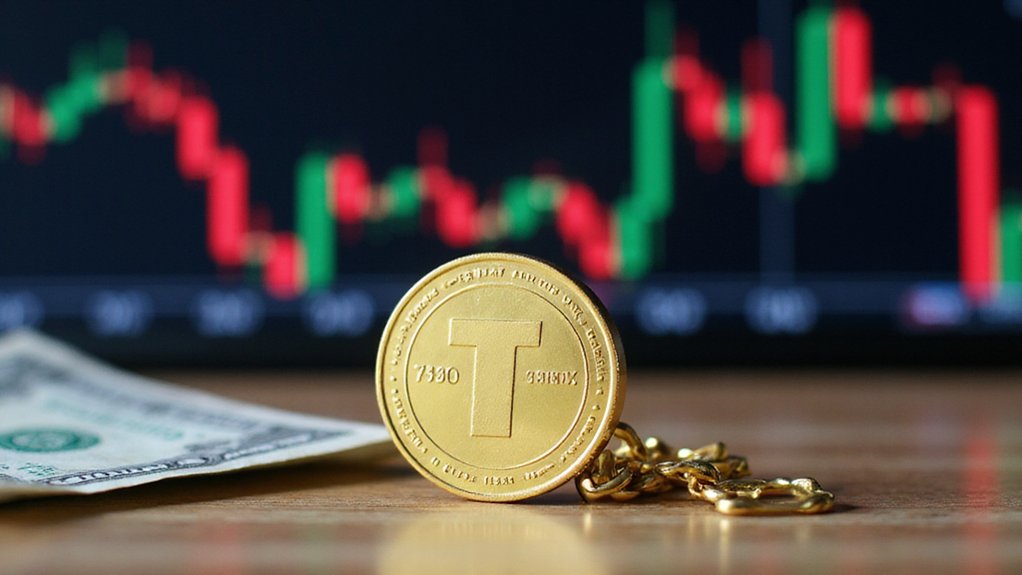Crypto tethering refers to stablecoins like Tether (USDT) that maintain a fixed value—typically 1:1—with traditional currencies. Unlike volatile cryptocurrencies, tethers provide stability by backing digital tokens with reserve assets. Operating across multiple blockchains, they facilitate trading, cross-border payments, and quick exits from volatile positions without fiat conversion. Despite their utility in bridging traditional and decentralized finance, questions persist about reserve backing and centralized governance. The financial innovation represents a pragmatic compromise in the wild west of digital assets.

The digital money revolution’s anchoring mechanism—stablecoins like Tether—has fundamentally transformed how value moves through the cryptocurrency ecosystem.
Stablecoins anchor the wild cryptocurrency frontier, providing essential stability in a financial landscape defined by volatility.
Tether (USDT), the pioneering stablecoin with a market capitalization exceeding $100 billion, maintains a purported 1:1 ratio with the U.S. dollar, offering market participants a rare island of relative calm in the notoriously turbulent crypto seas.
This financial innovation operates across multiple blockchain platforms including Ethereum, Algorand, and Solana, demonstrating remarkable technological versatility while retaining its cardinal virtue: stability.
Crypto tethering fundamentally provides a bridge between traditional fiat currencies and the decentralized digital economy.
Traders leverage USDT—and its less prominent variants like EURT, MXNT, and CNHT—to swiftly exit volatile positions without converting back to fiat currencies (a process fraught with fees and delays that would make even the most patient financier wince).
The concept has proven so effective that it has inspired numerous imitators, each claiming superior stability mechanisms or reserve transparency.
The practical applications extend well beyond mere trading convenience.
Cross-border payments, previously encumbered by exchange rate fluctuations and intermediary fees, can now traverse global financial boundaries with remarkable efficiency.
Merchants increasingly accept these digital dollars, appreciating their immunity to the price gyrations that make accepting traditional cryptocurrencies an exercise in financial roulette.
Lending markets, NFT ecosystems, and ICO participation all benefit from the predictable value proposition that tethering provides.
Stablecoins like Tether belong to a category of fiat-collateralized stablecoins that use reserve assets to maintain their price stability and value peg.
New tokens are created only when legitimately requested and purchased by customers who have completed strict KYC procedures to ensure regulatory compliance.
Launched originally as RealCoin in 2014, Tether quickly rebranded and established itself as the dominant stablecoin in the cryptocurrency market.
Yet this stability comes with caveats.
Tether Limited’s claims of 100% reserve backing have attracted persistent regulatory scrutiny—a reminder that even in the supposedly trustless blockchain world, trust remains an inescapable component of financial systems.¹
The paradox of centralized management in a decentralized ecosystem raises fundamental questions about governance and accountability.
Ultimately, crypto tethering represents the pragmatic compromise between revolutionary financial ideals and practical market requirements—an innovation that acknowledges volatility as cryptocurrency’s Achilles heel while providing a functional solution that enables the broader ecosystem to flourish despite this inherent limitation.
¹The company publishes reserve attestations rather than thorough audits—an important distinction.
Frequently Asked Questions
How Do I Avoid Being Targeted for Crypto Tethering?
To avoid being targeted for crypto tethering, users should implement robust security measures: utilize hardware wallets for cold storage, enable two-factor authentication on all platforms, maintain vigilant awareness of phishing attempts (those surprisingly convincing emails do seem to proliferate), and conduct transactions exclusively through established exchanges.
Regular software updates—tedious as they may be—constitute an essential defense mechanism, while the judicious practice of maintaining separate addresses for different transaction types provides an additional layer of operational security.
What Penalties Do Crypto Tetherers Face if Caught?
Crypto tetherers caught engaging in illicit activities face a multi-jurisdictional gauntlet of penalties ranging from substantial financial sanctions to incarceration.
Regulatory authorities, ever-vigilant in their monitoring of stablecoin transactions, may impose fines, freeze assets, or pursue criminal charges for money laundering, fraud, or market manipulation.
The severity varies dramatically by jurisdiction—what merits a slap on the wrist in one nation might warrant years behind bars in another.
Tax evasion penalties often compound these consequences.
Can Crypto Tethering Affect My Existing Cryptocurrency Investments?
Crypto tethering—that unfortunate practice of manipulating prices through coordinated trading—can indeed impact existing cryptocurrency investments.
Market manipulation distorts true asset valuation, potentially triggering artificial rallies or crashes that affect even uninvolved investors’ holdings.
The ripple effects extend beyond individual assets; widespread tethering undermines market integrity, erodes institutional confidence, and may invite regulatory crackdowns.
For the passive investor who merely sought exposure to digital assets, these manipulations represent an unaccounted-for risk factor that transcends normal market volatility.
Are Certain Cryptocurrencies More Vulnerable to Tethering Schemes?
¹As previously noted, proper diversification strategies remain essential for mitigating exposure to such vulnerabilities.
How Do Regulatory Bodies Track and Monitor Crypto Tethering Operations?
Regulatory bodies track crypto tethering operations through a multi-pronged approach that would impress even the most zealous surveillance enthusiast.
They deploy blockchain analysis tools to follow transaction patterns, enforce AML/KYC compliance through exchanges, utilize AI-powered anomaly detection systems, and—perhaps most effectively—coordinate internationally to share intelligence.
The FATF guidelines provide the backbone for this oversight, while specialized forensic technologies allow authorities to pierce through the veil of pseudonymity that once made crypto seem impenetrable to regulation.








